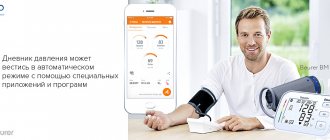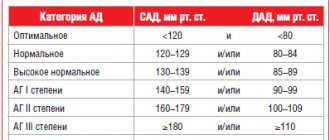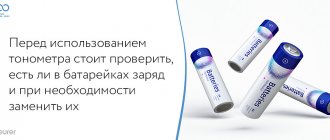Heart disease often creeps up unnoticed; as a rule, a person does not pay attention to problems in the functioning of the heart muscle. Therefore, cardiac arrhythmia is noticed when the disease reaches a severe stage. To prevent this from happening, it is necessary to regularly measure blood pressure and heart rhythm. To do this, you should purchase a tonometer with a function for measuring heart rate - automatic or semi-automatic. Arrhythmia indicator on a tonometer - what it is and how to track it - let's look at this question, the answer to which everyone who suffers from heart disease should know.
Introduction
Arterial hypertension has an extremely high prevalence not only in Russia, but also in the world and is one of the most important factors in the development of cardiovascular diseases and complications, such as myocardial infarction, stroke, coronary heart disease, chronic heart failure, cerebrovascular (ischemic or hemorrhagic stroke , transient ischemic attack) and renal (chronic kidney disease) diseases [1].
The prevalence of hypertension increases with age, reaching 60% or higher in people over 60 years of age [2]. Because the observed increase in life expectancy is accompanied by an aging population and a corresponding increase in the number of sedentary and overweight patients, the prevalence of hypertension is predicted to increase worldwide. According to the forecast, by 2025 the number of patients with hypertension will increase by 15–20% and reach almost 1.5 billion [3].
There are types of office blood pressure measurements:
Measurements in clinical trials. Such measurements are always carefully standardized and follow a protocol. Recently, they have been performed mainly with electronic devices.
Measurements in real clinical practice. Without strict adherence to measurement conditions, rest duration, patient position, number of measurements, averaging method, etc. Overestimated compared to point 1 by an average of 14/10 mm Hg. Art., however, this difference is approximate due to the lack of standardization of methodology [4].
Automatic office pressure measurement. On average, below point 1 by 5/5 mmHg. Art. and approximately corresponds to the daily values of 24-hour blood pressure monitoring. Eliminates many of the limitations of office measurements, but requires additional material resources and is not readily available [5].
Arterial hypertension is the most important risk factor for atrial fibrillation (AF), the most common stable cardiac arrhythmia, often leading to serious consequences and causing premature death in patients with this pathology. The RACE and AFFIRM studies found that the combination of AF with hypertension sharply increases the risk of thromboembolic complications, including stroke, despite anticoagulant therapy [6, 7]. Currently, hypertension is considered as a determining, independent, potentially reversible risk factor for the development of AF. The role of hypertension in the development of AF has been confirmed in several large clinical studies: STOP-2, CAPPP, LIFE [8–10]. That is why it is so important to diagnose an increase in blood pressure in a timely manner, which requires devices characterized by the greatest sensitivity and accuracy of measurements. Measuring blood pressure in patients with AF is difficult due to the high variability of indicators. To obtain a representative mean value, blood pressure should be measured as often as possible. Each measurement should be repeated at least 3 times in a row [11], since blood pressure variability in patients with AF is significantly higher than in patients with sinus rhythm.
Purpose of the study:
to identify indications for the use of different types of tonometers in patients with AF: mechanical type, automatic type with an arrhythmia indicator with cuffs on the shoulder and automatic type with an arrhythmia indicator with cuffs on the forearm.
How to measure blood pressure correctly
In addition to the quality of the tonometer itself, some other factors also influence the accuracy of the measurements. To get the most accurate results, try to follow these rules:
- Measure your blood pressure at rest, not after exercise or stress. Immediately before the manipulation, sit quietly for a few minutes and try to completely relax.
- The mobile phone should be put away.
- Carry out the manipulation in a sitting position, maximum - lying down if the person cannot sit due to poor health.
- Avoid drinking caffeinated drinks at least one hour before your procedure.
- Empty your bladder first.
- Take the most comfortable and relaxed position; the cuff should not squeeze your arm or, conversely, dangle freely. At the same time, it is advisable not to slouch and not talk.
- About 1.5 hours should pass after eating.
- Do not smoke! It would be better at all, but at least an hour before the procedure - for sure.
- The measurement area should be at heart level. When using a shoulder tonometer, the left hand rests on the table in a calm state, the wrist one is bent at the elbow and supported by the right hand.
- Feet should be flat on the floor. Don't cross them or sit cross-legged.
pixabay.com/cdz
Material and methods
The study was conducted from January to March 2021 by employees of the Department of Therapy, Clinical Pharmacology and Emergency Medical Care of the Federal State Budgetary Educational Institution of Higher Education MGMSU named after. A.I. Evdokimov Ministry of Health of Russia on the basis of the multidisciplinary hospital of the City Clinical Hospital named after. S.I. Spasokukotsky. The study included patients over 18 years of age with AF of any etiology, paroxysmal form, no more than 1 month old, as well as with a permanent form of AF (tachysystolic form), who consented to be included in the study. All patients had a history of hypertension of varying severity. The maximum duration of the study for each patient was 1 day. The exclusion criterion was the patient's refusal to participate in the study.
The study included 202 patients, of which 122 were women. The average age of the subjects was 61.8±1.3 years. Patients were divided into groups depending on the department where they were at the time of blood pressure measurement. In each group, sequential comparisons were made of data obtained by measuring with a mechanical tonometer and automatic blood pressure monitors with an arm cuff, as well as with a mechanical tonometer and automatic blood pressure monitors with a wrist cuff.
The work used a mechanical tonometer E-mega I (Riester), the readings of which served as a control, an automatic tonometer OMRON M2 BASIC HEM-7121-ALRU (OMRON M2 BASIC) with a built-in arrhythmia indicator, an automatic tonometer OMRON RS2 HEM-6121-Ru (OMRON RS2 ) and automatic tonometers from other manufacturers (B1 and A1 - automatic tonometers with cuffs on the shoulder, B2 and A2 - automatic tonometers with cuffs on the wrist (wrist tonometers)).
For the study, we selected devices that were as identical as possible in their technical characteristics, the main ones of which we consider: the presence of appropriate certificates for the devices, the presence of an arrhythmia indicator, the size of the cuff (for correct fixation on the shoulder/wrist), the possibility of using the power supply and/or batteries. Table 1 presents the main characteristics of the tonometers used, taken from the official websites of the companies and from the instructions for the devices.
Blood pressure measurements were carried out three times during the day: at 8:00, 12:00 and 16:00.
Measurements were carried out sequentially on the same hand. The intervals between measurements were 2–3 min:
1st measurement - “training” measurement with a mechanical tonometer;
2nd measurement - “training” measurement with the automatic tonometer being tested;
3, 5, 7, 9th measurements - experimental measurements with a mechanical tonometer;
4th, 6th, 8th measurements - experimental measurements with the device under test.
All patients included in the study had AF recorded on the electrocardiogram at the time of blood pressure measurement. The study was carried out in three departments: intensive care, general intensive care and therapeutic department.
Statistical processing of the data was carried out in Microsoft Excel 2010. To determine the statistical significance of the differences, the Mann-Whitney U test was used. Differences were considered statistically significant at p≤0.05.
Research results
The first group consisted of 68 patients, of which 36 were men, who were treated in the intensive care unit. The average age of the subjects was 65.4±1.1 years. 48 patients were diagnosed with ischemic cardiomyopathy, 8 with post-infarction cardiosclerosis, and 12 with toxic myocardial damage. The patients' condition is assessed as serious.
The results of measurements of systolic (SBP) and diastolic (DBP) blood pressure using the tested tonometers with an arm cuff and a mechanical tonometer are presented in Figure 1.
The differences between the SBP indicators of the OMRON M2 BASIC and B1 tonometers and the indicators of the mechanical tonometer were statistically insignificant (p≥0.05), the minimal difference from the indicators of the mechanical tonometer was observed when measured with the OMRON M2 BASIC tonometer. The deviation of the A1 tonometer readings from the mechanical tonometer readings was -6.8 mm Hg. Art. (p≤0.05).
As for the DBP values, the deviations of the OMRON M2 BASIC and B1 automatic tonometer readings from the mechanical tonometer readings were statistically insignificant and amounted to +0.1 and +1.5 mmHg. Art. respectively (p≥0.05). When comparing DBP indicators of a mechanical tonometer and an automatic tonometer A1, the difference in indicators was -7.5 mm Hg. Art. (p≤0.05).
When measuring pressure using wrist tonometers, the results presented in Figure 2 were obtained.
Analysis of SBP values showed that the deviation of the values of the B2 tonometer from the values of the mechanical tonometer was +9 mm Hg. Art. (p≤0.05), tonometer A2 - -9.2 mm Hg. Art. (p≤0.05). For the OMRON RS2 tonometer, the deviation was minimal and amounted to +0.6 mm Hg. Art. (p≥0.05).
In relation to DBP values, deviations from control values were +6.2 mm Hg. Art. (p≤0.05), -8 mm Hg. Art. (p≤0.05) and +0.1 mmHg. Art. (p≥0.05) respectively.
Thus, in the 1st group of patients in the general intensive care unit, only the OMRON RS2 and OMRON M2 BASIC tonometers had insignificant deviations when measuring SBP and DBP from the mechanical tonometer readings.
In group 2 there were 66 patients, of which 38 were women (the average age of all patients was 57.2±3.1 years), who were in the intensive care unit. 46 patients were diagnosed with ischemic cardiomyopathy, 10 with post-infarction cardiosclerosis, 8 with toxic myocardial damage, and 2 with thyrotoxicosis. The condition was assessed as severe in 35 cases, and as moderate in 31 cases.
The results of measuring blood pressure (Fig. 3) using a mechanical tonometer and automatic tonometers with a cuff on the shoulder showed that statistically significant deviations in SBP indicators throughout the day were demonstrated by B1 devices - +9.1 mm Hg. Art. (p≤0.05) and A1 - -8.7 mmHg. Art. (p≤0.05). For the OMRON M2 BASIC tonometer, the deviation of the SBP value from the results of a mechanical tonometer was +0.5 mm Hg. Art. (p≥0.05).
For DBP indicators, the following deviations were obtained relative to the control values of the mechanical tonometer: for the automatic tonometer B1 - +8.6 mm Hg. Art. (p≤0.05), for tonometer A1 - -7.3 mm Hg. Art. (p≤0.05), for the OMRON M2 BASIC device - +0.5 mm Hg. Art. (p≥0.05).
When measuring blood pressure using wrist tonometers, the values shown in Figure 4 were obtained.
When using the B2 tonometer, the deviations in SBP values relative to the values of the comparison tonometer were greater - +8.4 mm Hg. Art. (p≤0.05), when using the A2 tonometer - to the smaller side - -9.3 mm Hg. Art. (p≤0.05). The OMRON RS2 tonometer showed the minimum average deviation of SBP - -1 mm Hg. Art. (p≥0.05). The deviation of DBP indicators of automatic tonometers from mechanical ones for B2 was +10.5 mm Hg. Art. (p≤0.05), for A2 - -7.5 mm Hg. Art. (p≤0.05), for OMRON RS2 - +0.5 mmHg. Art. (p≥0.05).
Thus, in this group of patients, the values of SBP and DBP when using OMRON M2 BASIC and OMRON RS2 tonometers did not differ significantly from the data obtained when using a mechanical tonometer. Tonometers OMRON M2 BASIC, OMRON RS2 can be recommended for use in this group of patients to control blood pressure.
The third group of the study included 68 patients (46 of them women), whose average age was 62.6±1.5 years. 27 patients were diagnosed with ischemic cardiomyopathy, 26 with post-infarction cardiosclerosis, and 15 with toxic myocardial damage. The condition of 23 patients was assessed as moderate, 45 as satisfactory. The measurements were carried out in the therapy department.
When comparing the values of both SBP and DBP obtained using automatic tonometers with the indicators of a mechanical tonometer, no statistically significant differences were obtained (p≥0.05) (Fig. 5).
When measuring pressure using wrist tonometers, the values presented in Figure 6 were obtained. For SBP, the following deviations in values from the data of a mechanical tonometer were identified: for the B2 tonometer it was +10.9 mm Hg. Art. (p≤0.05), for tonometer A2 - -6.5 mm Hg. Art. (p≤0.05), for the OMRON RS2 tonometer - -0.8 mm Hg. Art. (p≥0.05).
As for DBP, the deviation from the control values for the B2 tonometer was +7.1 mmHg. Art. (p≤0.05), for tonometer A2 - -5.8 mm Hg. Art. (p≤0.05), for the OMRON RS2 tonometer - +0.7 mm Hg. Art. (p≥0.05).
Regarding group 3, we can conclude that all automatic blood pressure monitors with an arm cuff and the OMRON RS2 wrist tonometer determined values close to those of a mechanical tonometer and can be used for ambulatory blood pressure measurement in patients with AF.
Discussion
To achieve target blood pressure values, in addition to drug therapy, it is necessary to obtain objective data on SBP and DBP, which is sometimes difficult in patients with heart rhythm disturbances due to the possibility of device errors increasing with severity. The data obtained in three groups of patients showed that the results of measuring blood pressure in patients with arrhythmia of any severity using automatic tonometers OMRON M2 BASIC and OMRON RS2 are close and statistically indistinguishable from the results of measuring a mechanical tonometer.
The other devices studied (A1, A2 and B1, B2) had statistically significant deviations from the mechanical blood pressure meter, and these differences were more pronounced the more severe the patient's arrhythmia. The general trend in all groups: for tonometers A, blood pressure readings were lower than for the mechanical tonometer, for tonometers B - higher, and these differences were statistically significant.
Arrhythmia detection technologies
Some models of automatic blood pressure monitors are equipped with technologies for recognizing atrial fibrillation. As a rule, the essence of such technologies is to measure pressure using two methods - oscillometric and auscultatory (Korotkoff method).
Afib is a patented stroke risk detection technology developed by Microlife . Afib allows screening for atrial fibrillation during blood pressure measurement, which significantly increases the chances of early detection of the disease.
Duo Sensor technology Tensoval automatic blood pressure monitors . The main measurement mode is the Korotkoff method, but if the sonority of the heart sounds is very weak (which are not captured by the Korotkoff method), the oscillometric method is activated.
Nissei 's Twin Check technology also uses two measurement methods. The arrhythmia indicator icon indicates the presence of an irregular pulse.









